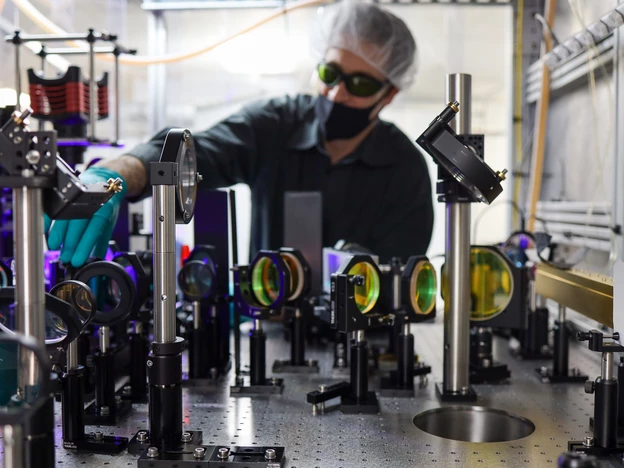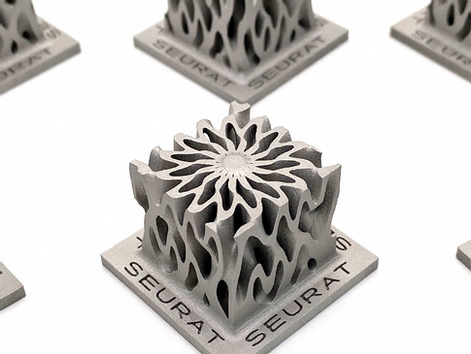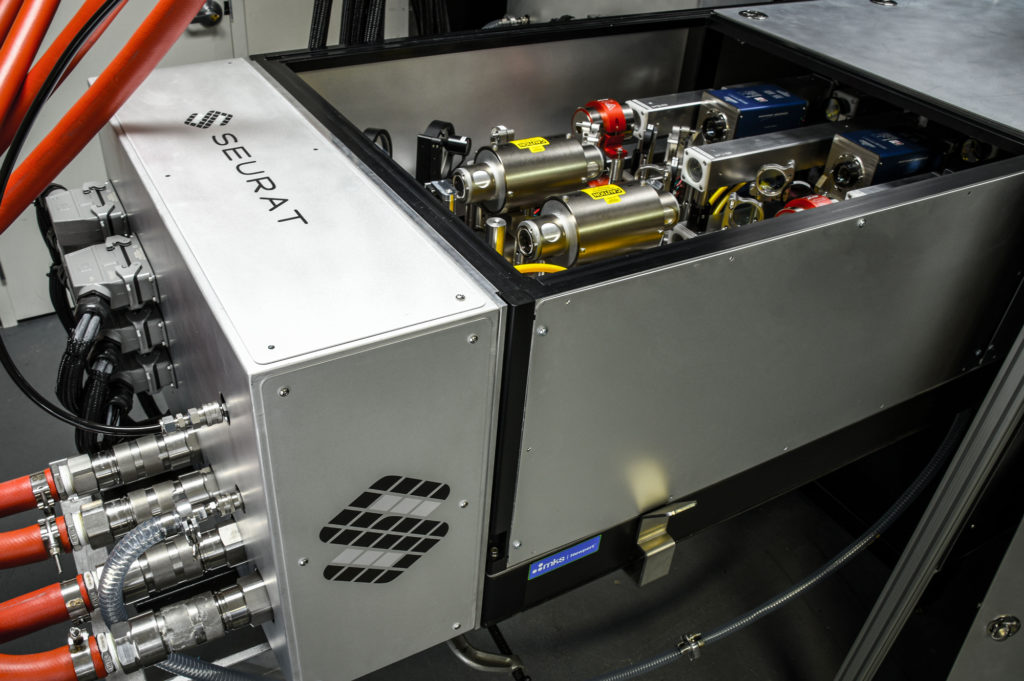U.S. metal 3D printing startup Seurat Technologies has reported that it already has demand for 25 metric tonnes of metal parts, filling the capacity for the firm’s pilot plant. This is more than they have capacity for. The company has signed Letters of Intent (LOI) with three manufacturers in tooling, energy and transportation. Parts are being qualified and the company hopes to start manufacturing parts in 2023.
 Seurat engineer developing Area Printing manufacturing technology. Image courtesy of Seurat Technologies.
Seurat engineer developing Area Printing manufacturing technology. Image courtesy of Seurat Technologies.Seurat’s 3D printing technology, Area Printing, relies on what the company calls Optically Addressed Light Valves (OLAVs) to direct two million points of light onto a bed of metal powder. This is a validation for the firm’s go-to-market strategy, which consists of it deploying its powder bed fusion (PBF) process in its own facilities and selling long-term capacity to large industrial firms. So, it’s not a service bureau and also not an OEM, but also not exactly an OEM that incubates a service before launching a machine. Seurat hopes to deploy its technology itself in an ever-expanding series of production plants that it will gradually expand. This kind of control and vertical integration is sure to appeal to investors. However, we were unsure if long-term deals on demand and continued production would be amenable and attractive to enough companies for Seurat to extend its production growth. It now seems that the firm has validated its approach, at least for now. This should be a wake-up call to 3D printing services and OEMs as it may mean that there is much more capacity out there in deals that could be attractive for them.
For now, Seurat is expanding the pilot facility into a factory with 100,000 sq. ft in floor space, powered by 100% green energy and capable of producing 500 tonnes of parts a year. Again, these kinds of volumes should point to significant interest from players such as GKN, Oerlikon and EOS.
 Seurat’s metal AM part. Image courtesy of Seurat.
Seurat’s metal AM part. Image courtesy of Seurat.Seurat CEO James DeMuth said of the development:
“Manufacturing must be closer to the customer. Having products produced in a faraway factory has clearly failed to be the best economic and environmental approach. Our novel Area Printing process can scale to outcompete traditional manufacturing in every way – cost, quality, and volume, while reducing our dependence on dirty fossil fuels. High volume orders of this magnitude are historic for the 3D metal printing industry and a tremendous step forward for the decarbonization of manufacturing.”
The company is positioning itself as a part of a green manufacturing revolution and sees itself as using the Inflation Reduction Act and CHIPS bill as a springboard to reduce emissions. The company also hopes to “competitively displace traditional manufacturing technologies like machining, casting, and forging, reducing GHG emissions related to waste material and related production energy requirements in addition to freight, transportation, and warehousing.¨
Gero Corman, head of digital innovation for group production at Volkswagen AG said,
¨Seurat’s factory deployment model enables contract manufacturing to happen closer to the customer which is highly attractive to the auto industry. Seurat’s 3D printing process has the potential to produce high volume parts at cost-parity to overseas manufacturing which will provide tremendous relief to supply chains.”
 Infographic that illustrates in ten steps the power of Seurat’s patented, game-changing Area Printing technology. Image courtesy of Seurat.
Infographic that illustrates in ten steps the power of Seurat’s patented, game-changing Area Printing technology. Image courtesy of Seurat.With $79 million in its coffers, the firm’s ambitions look distant. The company will need much more cash to make its complex, high-volume metal 3D printing technology a reality. However, with this milestone the company has at least demonstrated the logic of its approach. At the same time, positioning itself as a local manufacturing provider and a low green house gas alternative will be sure to attract government money as well as media interest.
 Seurat’s pulsed laser amplifier enables its industrial systems to manufacture at what the company calls “the fastest speeds in the 3D metal printing industry which enables highly competitive unit economics.” Seurat’s 2nd generation system will manufacture products at $150/kilogram. Image courtesy of Seurat.
Seurat’s pulsed laser amplifier enables its industrial systems to manufacture at what the company calls “the fastest speeds in the 3D metal printing industry which enables highly competitive unit economics.” Seurat’s 2nd generation system will manufacture products at $150/kilogram. Image courtesy of Seurat.The US has a pressing need to manufacture more of its military kit in-house and more quickly than it has done previously. Reshoring is a definite trend, as well. Companies are looking to it because of nationalism, environmental concerns and supply chain resilience worries. This positioning could be a powerful one. Large firms could see Seurat as a way to solve many supply chain issues by making things greener, closer to home, and at lower volumes. If Seurat can maintain momentum and grow its business there will be an inexorable self-supporting wave of interest in the process. If it can lower costs per part, manufacture on-demand and locally, well then it could essentially autocatalyze its own development and growth.
Seurat is one of the most exciting metal startups around today. Along with Mantle, Holo AM, Vulcan Forms and Velo3D, it could change the way that many things are manufactured. The industrialization of metal additive through automation and new technologies is the most important trend happening in our industry. Our future is being made now.
Subscribe to Our Email Newsletter
Stay up-to-date on all the latest news from the 3D printing industry and receive information and offers from third party vendors.
You May Also Like
Precision at the Microscale: UK Researchers Advance Medical Devices with BMF’s 3D Printing Tech
University of Nottingham researchers are using Boston Micro Fabrication‘s (BMF) 3D printing technology to develop medical devices that improve compatibility with human tissue. Funded by a UK grant, this project...
3D Printing Webinar and Event Roundup: April 21, 2024
It’s another busy week of webinars and events, starting with Hannover Messe in Germany and continuing with Metalcasting Congress, Chinaplas, TechBlick’s Innovation Festival, and more. Stratasys continues its advanced training...
3D Printing Webinar and Event Roundup: March 17, 2024
It’s another busy week of webinars and events, including SALMED 2024 and AM Forum in Berlin. Stratasys continues its in-person training and is offering two webinars, ASTM is holding a...
3D Printed Micro Antenna is 15% Smaller and 6X Lighter
Horizon Microtechnologies has achieved success in creating a high-frequency D-Band horn antenna through micro 3D printing. However, this achievement did not rely solely on 3D printing; it involved a combination...





























